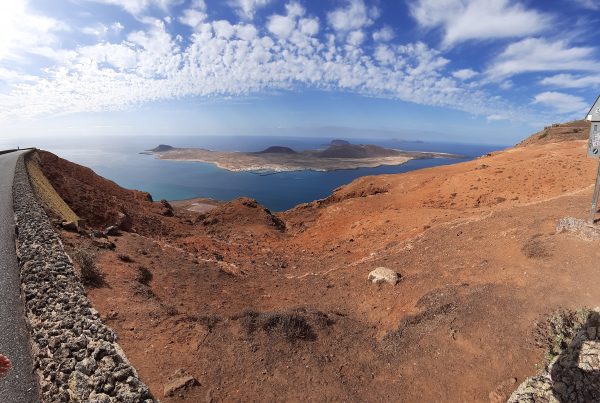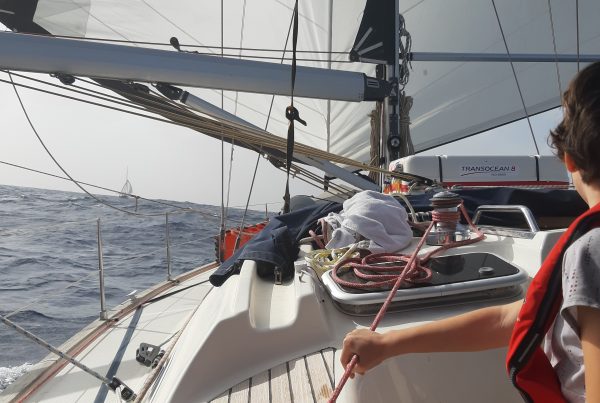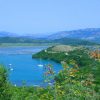Summary: All is together with the boat, and we’re idling at the marina waiting for a window to make the jump to Gibraltar, which currently is expected to happen Monday afternoon.
Fun fact — tides only flow *into* the Med; never out, and they can get reasonably speedy through Gibraltar. Where do all those billions of cubic meters of water go that pour in every day? (The answer is below.**)
Andy, featured in the last update “tuning the rig”, as it turned out ended up coming out 3 days running to get all things sorted. The main aspects of rigging took about a day, but he’s got an eye for details — most interesting thing he found was that the bearing at the top of the main sail wasn’t running smooth, and might be damaged; normally this requires pulling it out the top of the mast… which is about 6 hours with a crane.

The great news is that they found a way to get this part out the bottom of the mast, and thereby save a tonne of crane money; also we were concerned that it would require ordering parts, more delays — the part ended up being fine, just a retaining ring had slipped, and so the bearing pack wasn’t quite where it should be, but the issue had been caught before anything had worn badly, etc.

Otoka has a main sail that gets rolled up inside the mast; there is a long pole inside that mast that has a gear at the bottom, which allows you to force the pole to spin, and wrap the main sail around it. Once a year or so, you need to load the main sail into the mast; there is a travelling bit which the top of the sail attaches to, which you then use a cable to drag up to the top of the mast.
Once it’s up there, it provides a bearing that this pole spins around, and keeps tension on the sail that it doesn’t get wrinkled/jammed as you wind it in and out of the mast. Anyway, that bearing is the piece we thought was broken — and having it broken would mean that you’d probably be sitting in heavy winds with your sail half-deployed, and no good options for dealing with it. Nick would not go sailing with a risk like that, so having it dealt with easily was a tremendous boon.
Of course, there is a mountain of fine-grained detail in how a mast gets anchored to a boat; I’ve been poking through a couple of books here, and it seems like it would be pure foolishness for me to sound off on it. It was fascinating watching them all talk through the tuning process though.
I’ll refrain from discussing sailing until I’ve had some actual fresh, direct, experience involving salt-spray and such before I say more about that. Perhaps Monday will provide that opportunity.
There were two other important things — zinc anodes and a new prop — so we headed out of the marina to bob around “off-shore”, so Nick and a friend from Vesna could do some diving in clean water.
Zinc Anodes are lumps of zinc that are bolted to the various spots on the bottom of the boat; they provide a handy target for corrosion — they melt away into the seawater, and your precious metal boat parts don’t turn to rust.

A specific pair of anodes on the boat has been melting a bit quicker than expected (lasted only 6 months), so Nick is keeping an eye out for what might be causing that, but in the meantime, they keep doing their job.
Vesna is a fount of helpfulness — in this case, Skipper Jack has a history of commercial diving (something on the order of 10,000+ dive hours), so is just an amazing sort of overkill to bring to the party when it comes to working a 2m of depth on a sailboat.
While the necessary work was done on Otoka, Jack’s family was celebrating a long-anticipated repair/replacement/upgrade of their tender motor (now a new 20 HP motor!), as seen here, through their life-ring:

While we are talking about boat systems, the freshwater lines from the marinas are not considered the pinnacle of Water Safety, so what’s a sailor to do?

Yes — grab some standard filters, a cheap RO unit, and run the incoming marina water supply through it — makes it reliably nice and safe, and when you head out to sea, you can just stow the bits.
I also got a chance to provide some timely assistance to another member of this group of boats — diagnosed a dead hard drive, and reinstalled Windows! My Marine IT Career is in begun!
So, details on the jump to Gibraltar: the weather is predicted to be very calm; all the various models are in agreement (more about those on another post) that it will be minimal to no wind, and steady motoring for about 22 hours to get from here to there.
That constant inflow of water from the Atlantic means that prevailing current tends to be against us — 0.5 knots up to as much as 3 knots, depending on how far offshore we are, so the more we hug the shore, the faster we go.
The only issues with that is recent storms have brought a lot of debris into the water, so we’ve heard tell of logs and such floating around, which we’d rather not slam into a night, so that may have us keeping our distance — that was more than a week ago, so we’ll know better once we are out there.
I made some of Oma’s potato salad as my contribution to passage food, and will probably be working up a batch of War-Time Jambalaya in the morning as well.
I also started reading Susan Cooper’s “Greenwitch” to the girls tonight; seems to be well begun, and we’ll keep trying to find time for that sort of thing.
Now that we are in motion, I should have more news again soon!
Todays moment-of-zen image is this mysterious drawing, inexplicably found on the dock just aft of our boat — I believe it is a sign from the gods that forture will favour our voyage:

-C!
** Where does the water go? Evaporation, I’m told — apparently the Med is hot and dry enough that the water just evaporates like nobodies business.







sounds like you guys are ready for the trip! Enjoy!